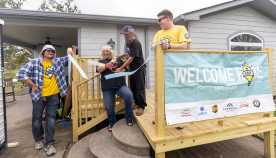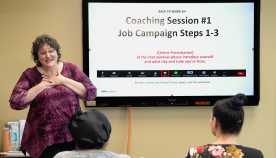About Us


Ping Lee, 42, is deeply invested in Philadelphia’s Chinatown, both personally and professionally. But that hasn’t always been the case.
Ping moved to Philadelphia from Hong Kong in 2001 to pursue a degree in computer science. On the way home from the airport, her host mother drove through Chinatown. “She thought it would make me feel less homesick, but I didn’t really feel a bond with it at first.”
When Ping transferred from a community college in the suburbs to Drexel University in downtown Philadelphia, Chinatown became a part of her everyday life. She shopped for groceries and frequented restaurants there, and she played volleyball with a Chinatown youth organization. She soon got a job as a secretary at a small Chinatown business. “That’s when I really started to see everything Chinatown has to offer,” remembers Ping.
It was the beginning of a lasting bond. In 2013, Ping began volunteering at the Philadelphia Chinatown Development Corporation (PCDC), an AARP Foundation grantee dedicated to meeting the needs of Chinatown's low-income immigrant community and preserving the thriving business district. Established in 1966, PCDC helps more than 2,000 clients a year with housing, food access, small business assistance, wellness programs and more.
"Recent immigrants face so many struggles,” says Ping. “It can be really difficult for them to feel any sense of belonging in their new country.” Now Ping serves as a housing program manager, spending her days helping the Chinese population gain access to housing. She also puts them in touch with other PCDC staff who can help them access other benefits. “I’ve met people who had been here for ten years and hadn't gotten the help they needed because they didn't speak the language," she says.
Many first-generation Chinese immigrants rely on their children for help with administrative tasks that require English, but most members of the younger, American-born generation never learned Chinese. “When they first got here, the first generation worked seven days a week, so they didn’t really spend time with their children,” she says. “There really isn’t much communication between them.” Ping, who is bilingual, helps bridge that gap.
She educates clients about resources available to them and about their rights. “The population we serve is very conservative,” says Ping. “They don't want to ask for assistance because they feel like they are taking advantage.” This mindset means it can take time and consistency to establish trust, but Ping is undeterred. “If you make sure you’re always there to help, they keep coming back.”
Ping acknowledges the challenges, including clients’ frustration with complex bureaucratic systems and the emotional toll of dealing with people who are struggling to meet their most basic needs. However, the gratitude her clients express and seeing them become more self-sufficient make it worthwhile.
Ping has high hopes for Philadelphia’s Chinatown district and the impact PCDC has on the community. “I feel the loneliness of immigrants, because you don’t just leave your country, you leave your culture,” she says. “But we have this community that people can be proud of. We don’t just help with benefits; we bring people back to their roots.”
Learn more about how AARP Foundation Grants Program helps older adults to secure the essentials.
Read more stories about how our programs have helped people find hope, and about the volunteers who give so much of themselves to help others.

















